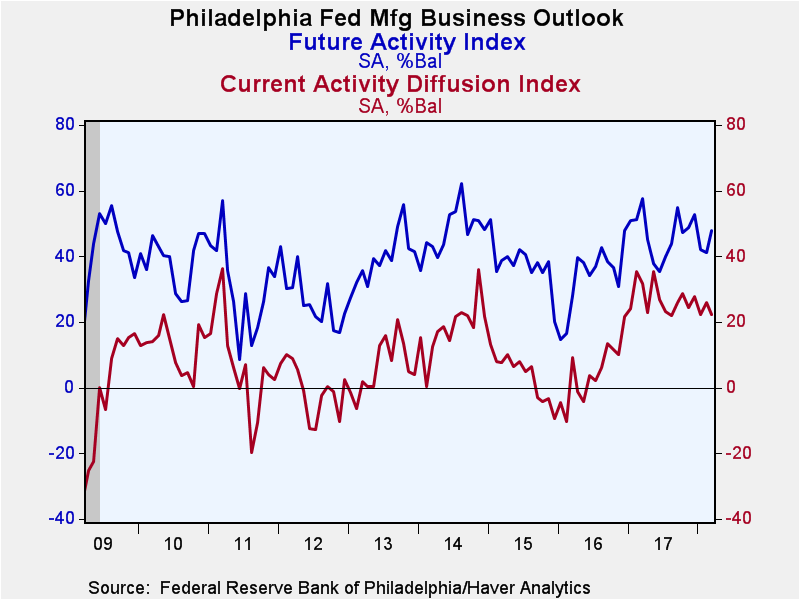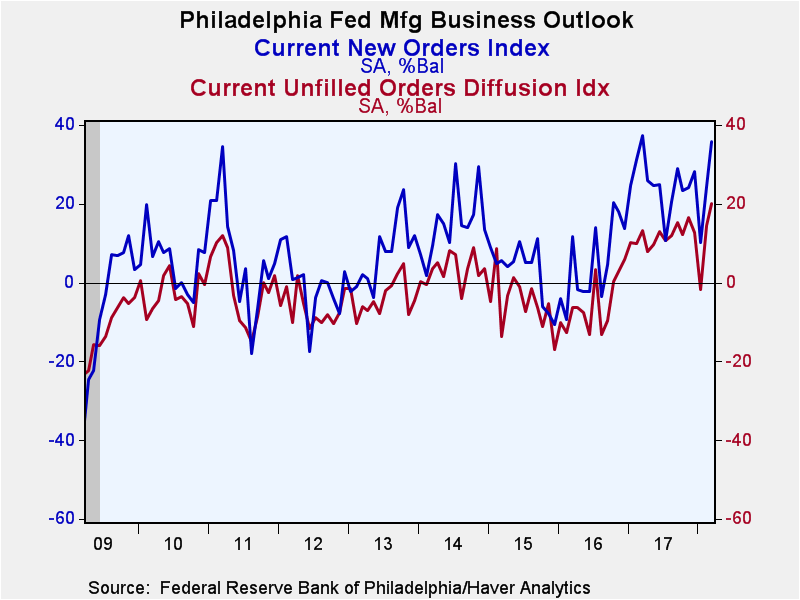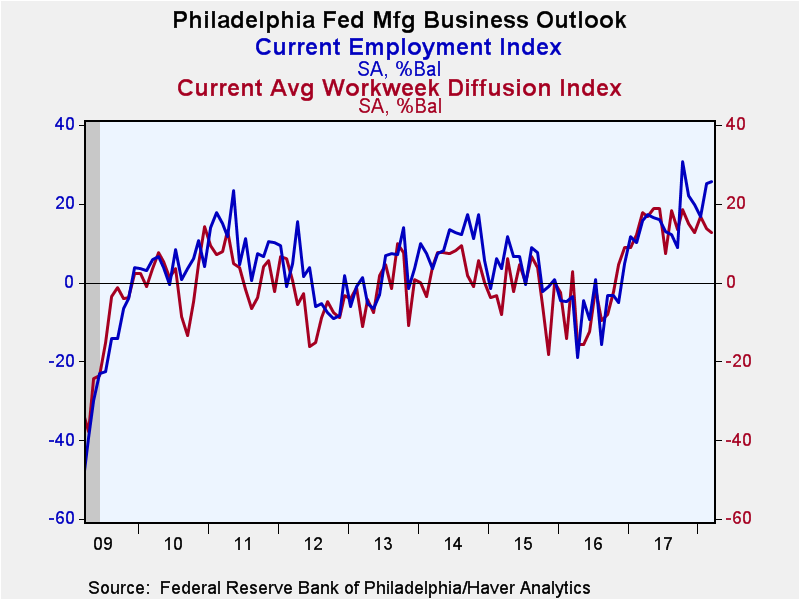 Global| Mar 15 2018
Global| Mar 15 2018Philadelphia Fed Factory Conditions Declines; Prices Ease
by:Tom Moeller
|in:Economy in Brief
Summary
The Philadelphia Federal Reserve reported that its General Factory Sector Business Conditions Index fell to 22.3 during March and reversed February's rise. Expectations had been for a reading of 23.0 in the Action Economics Forecast [...]
The Philadelphia Federal Reserve reported that its General Factory Sector Business Conditions Index fell to 22.3 during March and reversed February's rise. Expectations had been for a reading of 23.0 in the Action Economics Forecast Survey. A lessened 37% of firms reported an improvement in business activity while a steady 14% reported a decrease. As a diffusion index, readings above zero indicate expansion.
Haver Analytics constructs an ISM-Adjusted General Business Conditions Index. This measure strengthened this month to 61.9, the highest level since October 1988. During the last ten years, there has been a 68% correlation between the quarterly ISM-adjusted Philadelphia Fed Index and quarterly real GDP growth
The decline in the composite index was accompanied by improvement in many of the sub-series. New orders, shipments, unfilled orders and inventories each rose sharply. The rise in the vendor delivery index suggested sharply slower product delivery speeds.
The employment index nudged up to the highest level since October. During the last ten years, there has been an 80% correlation between the index level and the m/m change in payroll employment. A strengthened thirty-five percent of respondents reported a rising level of payrolls while nine percent reported a decline. The average workweek series eased slightly and has been moving sideways for a year.
The prices paid index slipped to 42.6, but remained near the highest level since May 2011. Forty-four percent of respondents reported higher prices while one reported lower. The index of prices received declined to the lowest level in three months.
The future activity index improved following declines during the prior two months. Shipments and unfilled orders fell sharply. Employment and prices paid eased, but remained in strong up-trends.
The survey panel consists of 150 manufacturing companies in the third Federal Reserve District (which consists of southeastern PA, southern NJ and Delaware). The diffusion indexes represent the percentage of respondents indicating an increase minus the percentage indicating a decrease in activity. The ISM-adjusted figure, calculated by Haver Analytics, is the average of five diffusion indexes: new orders, production, employment, supplier deliveries and inventories with equal weights (20% each). Each ISM-adjusted index is the sum of the percent responding "higher" and one-half of the percent responding "same."
The figures from the Philadelphia Federal Reserve can be found in Haver's SURVEYS database. The expectation from the Action Economics Forecast Survey is available in AS1REPNA.
| Philadelphia Fed - Manufacturing Business Outlook Survey (%, SA) | Mar | Feb | Jan | Mar'17 | 2017 | 2016 | 2015 |
|---|---|---|---|---|---|---|---|
| General Factory Sector Business Conditions | 22.3 | 25.8 | 22.2 | 31.6 | 27.4 | 4.8 | 3.7 |
| ISM-Adjusted Business Conditions | 61.9 | 56.6 | 56.5 | 59.7 | 57.2 | 48.2 | 49.4 |
| New Orders | 35.7 | 24.5 | 10.1 | 37.4 | 25.4 | 4.9 | 3.0 |
| Shipments | 32.4 | 15.5 | 30.3 | 33.2 | 26.8 | 6.9 | 3.1 |
| Unfilled Orders | 20.1 | 14.5 | -1.8 | 13.1 | 11.9 | -5.6 | -5.1 |
| Delivery Time | 14.0 | 4.5 | 6.1 | 5.5 | 10.6 | -4.6 | -4.2 |
| Inventories | 16.5 | -0.9 | 9.4 | 9.9 | 2.8 | -9.6 | -1.4 |
| Number of Employees | 25.6 | 25.2 | 16.8 | 15.8 | 16.2 | -5.6 | 3.9 |
| Average Workweek | 12.8 | 13.7 | 16.7 | 17.7 | 14.9 | -5.4 | -1.7 |
| Prices Paid | 42.6 | 45.0 | 32.9 | 38.6 | 30.4 | 13.5 | 1.5 |
| Expectations - General Business Conditions; Six Months Ahead | 47.9 | 41.2 | 42.2 | 57.6 | 47.1 | 33.7 | 37.6 |
Tom Moeller
AuthorMore in Author Profile »Prior to joining Haver Analytics in 2000, Mr. Moeller worked as the Economist at Chancellor Capital Management from 1985 to 1999. There, he developed comprehensive economic forecasts and interpreted economic data for equity and fixed income portfolio managers. Also at Chancellor, Mr. Moeller worked as an equity analyst and was responsible for researching and rating companies in the economically sensitive automobile and housing industries for investment in Chancellor’s equity portfolio. Prior to joining Chancellor, Mr. Moeller was an Economist at Citibank from 1979 to 1984. He also analyzed pricing behavior in the metals industry for the Council on Wage and Price Stability in Washington, D.C. In 1999, Mr. Moeller received the award for most accurate forecast from the Forecasters' Club of New York. From 1990 to 1992 he was President of the New York Association for Business Economists. Mr. Moeller earned an M.B.A. in Finance from Fordham University, where he graduated in 1987. He holds a Bachelor of Arts in Economics from George Washington University.










